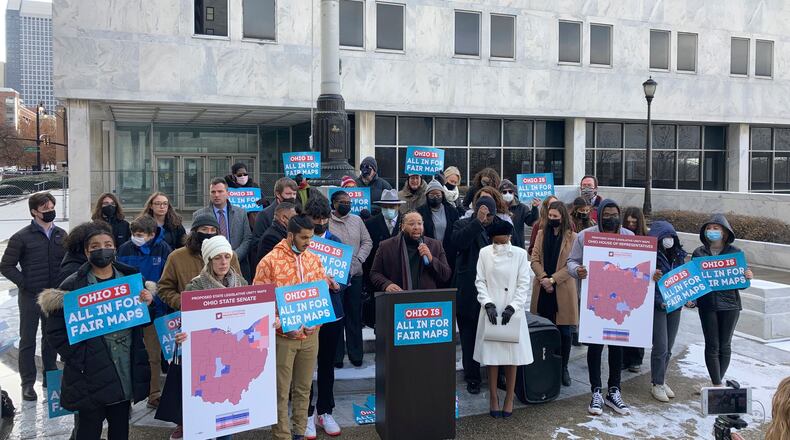“This ruling sends a clear message to lawmakers in Ohio: They may not put politics over people,” said Freda Levenson, legal director for the ACLU of Ohio, one of the plaintiffs.
Justices voted 4-3 to overturn the maps.
Ohio Gov. Mike DeWine, a member of the redistricting commission, called for the other Republicans to cooperate with Democrats during the debates over new legislative seats. But he ultimately voted for the Republican map.
“Throughout this process, I expected that Ohio’s legislative maps would be litigated and that the Ohio Supreme Court would make a decision on their constitutionality,” DeWine said. “I will work with my fellow Redistricting Commission members on revised maps that are consistent with the court’s order.”
In 2015 Ohio voters overwhelmingly approved a state constitutional amendment to create the redistricting commission in an attempt to end partisan gerrymandering for seats in the Ohio General Assembly.
The commission met for the first time last summer. The Republican-dominated commission voted 5-2, with the two Democratic members opposed, to adopt the maps at midnight Sept. 15 — the deadline for the commission to act.
The ruling Wednesday came in the case League of Women Voters of Ohio v. Ohio Redistricting Commission, a consolidation of three lawsuits challenging the maps. The court heard oral arguments in the case on Dec. 8.
“We really commend the Ohio Supreme Court for standing with voters and defending democracy,” said Jen Miller, executive director of the League of Women Voters of Ohio.
In approving the constitutional amendment, voters sought a mapmaking process that was transparent and bipartisan, which kept communities whole and served voters’ interests instead of partisan candidates’, Miller said.
Now the seven-member redistricting commission has 10 days to adopt new maps.
“We will be using these 10 days to call for maps that truly serve the people of Ohio,” Miller said. That means urging Ohio residents to call their lawmakers and the commission members.
Miller said she sincerely hopes this time commissioners will work across the aisle to create fair maps.
Representatives for two Republican commission members — co-chair House Speaker Bob Cupp and Secretary of State Frank LaRose — both issued short statements that they were “reviewing the decision.”
The state Democratic Party immediately hailed the ruling as vindication of its claim that the maps are unconstitutionally gerrymandered.
“Twice, Ohioans overwhelmingly demanded change and fair representation, and I’m glad that the Ohio Supreme Court listened,” Democratic Party Chair Elizabeth Walters said. “The Supreme Court today recognized what Ohioans already knew — GOP politicians tried to ram through an unconstitutional map that further rigs the state in favor of one party over another. Now that the Supreme Court has ruled, it’s imperative that the commission actually do their jobs this time and create maps that reflect our state, not a Republican party wish list.”
She called on the commission’s Republicans to “finally put politics aside” and create fair maps.
The Supreme Court retains jurisdiction over the ordered new maps, according to the order signed by Chief Justice Maureen O’Connor. Once a new plan is adopted, parties will have three days to file any further objections.
Also before the court is a consolidated case challenging the new U.S. House district map that state legislators approved in November — also along strictly partisan lines.
Wednesday’s ruling bodes well for that case, Miller said.
“I’m certainly hopeful for the Congressional map,” she said. “The evidence is very similar.”
In that case, too, it’s clear the map-drawing process was “rigged” to unfairly boost one party, Miller said.
The filing deadline for state legislative seats is Feb. 2, with party primaries set for May 3.
About the Author

